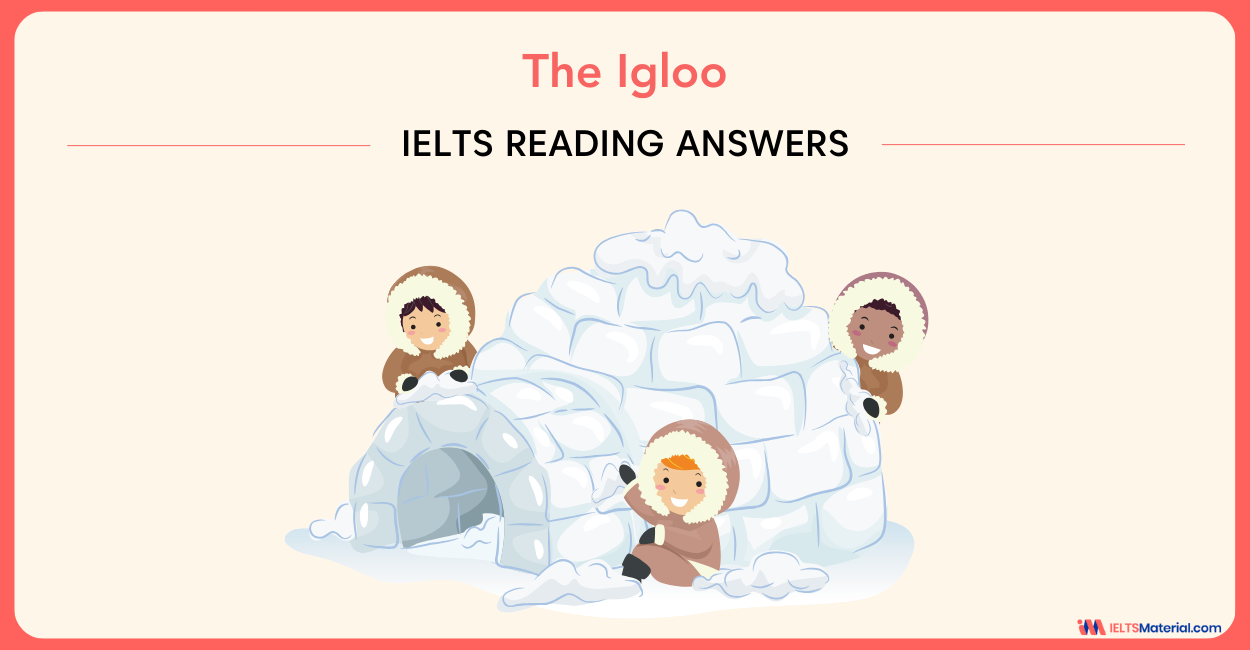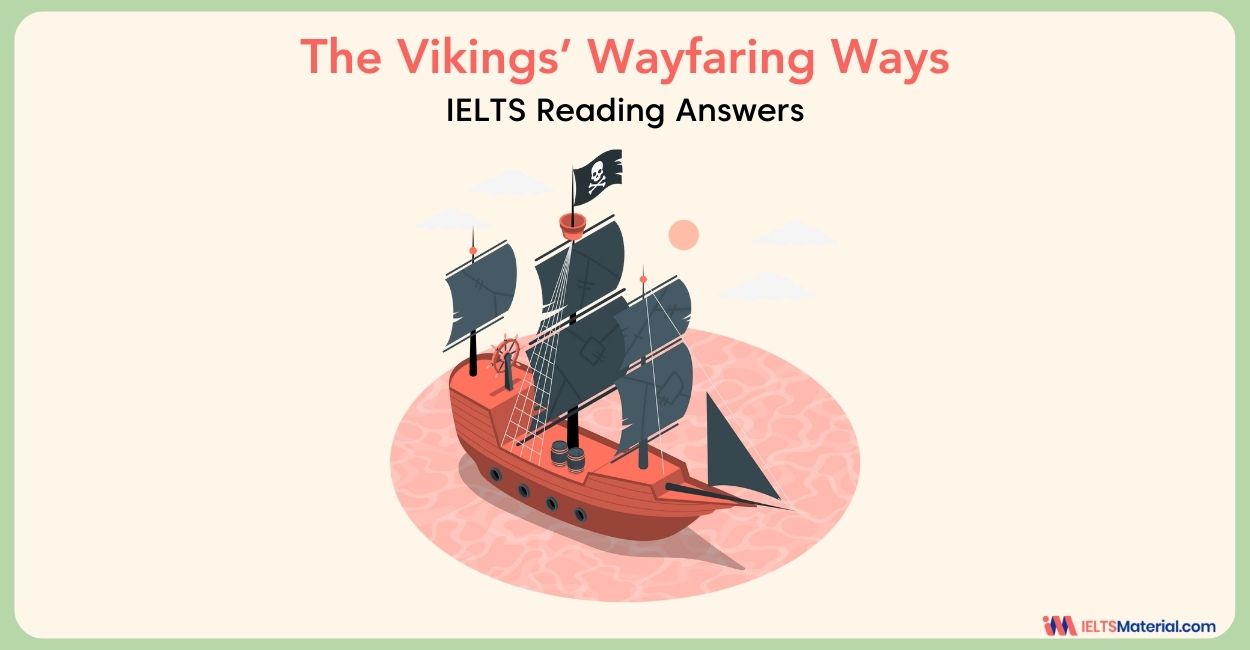The Vikings’ Wayfaring Ways - IELTS Reading Answers
Looking to practice IELTS Reading? Dive into the passage on The Vikings’ Wayfaring Ways - IELTS Reading Answers and learn the strategies for different question type and level up your preparation for a band score of 8+.
Table of Contents
- Types of Questions in The Vikings’ Wayfaring Ways - IELTS Reading Answer
- Tips to Solve Question in the Vikings’ Wayfaring Ways - IELTS Reading Answers for a Band 8+
- Reading Passage on the Vikings’ Wayfaring Ways - IELTS Reading Answers
- The Vikings’ Wayfaring Way IELTS Reading Answers With Explanation

Limited-Time Offer : Access a FREE 10-Day IELTS Study Plan!
In the IELTS Reading, you will be assessed on your reading skills where you will encounter different question types which you must answer within a limited time frame. With the passage on ‘The Vikings’ Wayfaring Ways - IELTS Reading Answer’, this would be a useful IELTS Academic Reading passage for test preparation. It helps you understand the types of passages and questions you’ll encounter in order to score well. However, remember to review the passage’s answers with explanations to learn about the question types and difficulty level to score a band 8+ in the IELTS exam.
Let’s dive into the passage on ‘The Vikings’ Wayfaring Ways Reading Answer’ and level up your preparation!
Types of Questions in The Vikings’ Wayfaring Ways - IELTS Reading Answer
As there are different question types, this IELTS Reading passage on ‘The Viking Wayfaring Ways’ includes 13 questions, featuring the following :
- Short Answer Type Questions(Q1 – Q5)
- Summary Completion (Q6 – 13)
Ideally, you should spend about 20 minutes on Questions 1-13 which are based on the Reading Passage, ‘The Viking Wayfaring Ways Reading Answer’. It is necessary to prepare with IELTS Reading Practice Tests so that you can acquire the reading skills needed to excel in the IELTS exam.
Check out the video below to become familiar with the strategies to attempt IELTS Reading Summary Completion Questions.
Tips to Solve Question in the Vikings’ Wayfaring Ways - IELTS Reading Answers for a Band 8+
Since now you are aware of the types of the questions in the ‘The Vikings’ Wayfaring Ways’ Reading Answers, let us check out some quick reading tips to answer the passage question types in the the Vikings’ Wayfaring Ways Reading Answers.
Short Answer Question:
Short Answer Questions require test takers to provide brief responses (usually one or two words) based on information from the passage.
- Read Instructions Carefully: Pay attention to the word limit for each answer (e.g., “No more than two words”).
- Identify Keywords: Highlight key phrases in the questions to locate relevant sections in the text.
- Skim and Scan: Skim the passage for the main ideas and scan for specific details related to the questions.
- Use Context for Accuracy: Read surrounding text to ensure your answer fits the context of the question.
- Check Grammar and Spelling: Ensure your answers are grammatically correct and spelled accurately, as this can affect your score.
Summary Completion:
Summary Completion is a type of reading question in the IELTS exam that requires you to fill in a gap in a paragraph with a word or phrase from the passage.
To answer summary completion questions, you can use the following strategies:
- Reading the sentences carefully will give you an idea of the type of word or phrase that is missing.
- Next, scan the passage for the keywords. The keywords in the sentence can help you to identify the correct word or phrase.
- Read the sentence with the missing word or phrase. It will help you to see how the word or phrase fits into the sentence.
- Finally, check your answer. Once you have filled in the gap, make sure that your answer makes sense in the context of the sentence.
Want to know How to Complete IELTS Reading in Less than an Hour? Check out the tips and achieve a band score of 8+.
Reading Passage on the Vikings’ Wayfaring Ways - IELTS Reading Answers
The IELTS Reading Passage on ‘The Vikings’ Wayfaring Ways Reading Answers’ is from Section 1 where you would have to answer the questions in 20 minutes. It is ideal to use a stopwatch to check your progress and become aware of the time taken as well as your progress.
Let’s start the test now!
Find the practice test with The Vikings Wayfaring Ways PDF here.
The Vikings’ Wayfaring Way IELTS Reading Answers With Explanation
Now, it’s time to check the answers for the passage on ‘The Vikings’ Wayfaring Ways - IELTS Reading Answers’. Here’s a detailed explanation of the answers for the ‘Vikings’ Wayfaring Ways ‘ IELTS Reading Passage.
|
Question |
Answer |
Explanation |
|
1 |
793 |
The initial lines of paragraph B clearly mention that “during their first expedition, in 793, a force of Viking warriors sacked the famed abbey at Lindisfarne, on England’s northeast coast.” Since the word ‘sacked’ means plundering or pillaging, especially after capture, to obtain spoils of war from. We can infer that Vikings raided the abbey coast of England in 793. Hence, the correct answer is ‘793’. |
|
2 |
980 |
As per paragraph C’s initial line, “In 980, an Icelandic assembly found a man named Eric ‘the Red’ Ericson guilty of the murder and sent him into exile.” Since the words ‘guilty of murder’ means ‘convited of crime.’ Therefore, this line confirms that in 980, Eric the Red was convicted for murder. Hence, the correct answer is ‘980’. |
|
3 |
841 |
The line “to the west, they con-quered portions of Ireland, and in 841 founded Dublin, today a major Irish city, but originally a Viking fort.” Paragraph D confirms that the fort which was acquired in 841 was originally a Viking fort. Hence, the correct answer is ‘841’. |
|
4 |
911 |
In paragraph E, the line states that “to stop the raids, French King Charles III in 911 offered the Viking chief Rollo territories in northwest France, called Normandy, after the Normas or ‘Northmen’.” Rollo territories are land pieces, and French King offered it to the Viking chief in 911. Hence, the correct answer is ‘911’. |
|
5 |
1066 |
Paragraph E discusses that “they set up a powerful kingdom and, in 1066, under William, Duke of Normandy defeated King Harold at the battle of Hastings in England.” Duke of Normandy is a Viking warrior, and he defeated England King Harold in 1066. Hence, the correct answer is ‘1066’. |
|
6 |
D |
Paragraph A states that “Vikings were also the most far-ranging of peoples. The term Viking, in Old Norse, means ‘to go on an expedition.’ From the late 700s until the eleventh century, Viking explorers journeyed from their native Norway, Denmark, and Sweden to many distant lands.” From these lines, we can infer that Vikings were known as explorers. Hence, the correct answer is ‘explorers.’ |
|
7 |
H |
Paragraph C states that “Ericson, and a small Viking fleet sailed west to North America. There they established the first European settlement in the New World, called ‘Vinland’.” As the word, ‘established’ means to settle. Therefore, we can deduce that Vikings were the first European who settled in North America. Hence, the correct answer is ‘settled in.’ |
|
8 |
F |
The first few lines of Paragraph D mentions that “Vikings from Denmark, meanwhile, ravaged large swaths of England and France. In 866, a Viking ‘Great Army’ landed in England, occupying much of the country’s north and east.” These lines confirm that Vikings from Denmark occupied or took control (conquered) over a large area of England and France. Hence, the correct answer is ‘conquered.’ |
|
9 |
G |
Paragraph F mentions that “Vikings had raided Portugal and Spain, then largely controlled by Arab Moors.Also, the Moors dealt them a rare defeat. The Moors catapulted flaming projectiles onto the Viking vessels, forcing a retreat.” The phrase ‘moors catapulted flaming projectiles’ means forcefully throwing flaming objects. Hence, the correct answer is ‘burning objects.’ |
|
10 |
B |
Paragraph G confirms that “In 902, hundreds of Varagians served as marines during a Bzyantine naval assault on the island of Crete.” This line means that they took part in the Byzantine attack (assault) on the Island of Crete. Hence, the correct answer is ‘an attack.’ |
|
11 |
O |
Paragraph H mentions that “Vikings journeyed through the Baltic Sea, then built inland posts in Germany and Poland. In time, they struck out across Central and Eastern Europe, down the Vistula River in Poland, and the Don Rivers in Russia. Further, Viking merchants on horseback penetrated far into the Asian heartland.” These lines indicate that Vikings traveled down the Russian River and then journeyed deep into Asia on the horse. Hence, the correct answer is ‘horse.’ |
|
12 |
C |
According to Paragraph I lines, “after lucrative trade relations were established with the Byzantines and with Muslim lands, the Rush moved their capital southward to Kiev, later the capital of Ukraine.” From these lines, we can infer that Viking leaders expanded their territories towards the south and eventually formed Vikings’ territorial capital. Hence, the correct answer is ‘capital.’ |
|
13 |
K |
The beginning lines of Paragraph J states that “another important Viking market town was Bulgar, on the Volga River. There, merchants peddled honey, wax, amber, and steel swords.” These lines indicate that Vikings had an important market in the town of Bulgar. Hence, the correct answer is ‘market.’ |
How was it? Did you get the answers? Always remember to note the areas of improvement to achieve a band score of 8+ in the IELTS exam. With consistent practice, you will be able to acquire the key skills needed to excel in the Reading Section, even if you attempt the IELTS General Reading. Therefore, continue the practice with more tests and take a step closer to your desired band score.
Want to Improve Your IELTS Reading Skills, Book your session with IELTS Experts now!
Check More IELTS Reading Answers
Also check :
Practice IELTS Reading based on question types

Start Preparing for IELTS: Get Your 10-Day Study Plan Today!
Explore other Reading Topics

Kasturika Samanta

Kasturika Samanta

Kasturika Samanta

Kasturika Samanta
Recent Articles

Nehasri Ravishenbagam

Haniya Yashfeen

Haniya Yashfeen

Haniya Yashfeen




Post your Comments